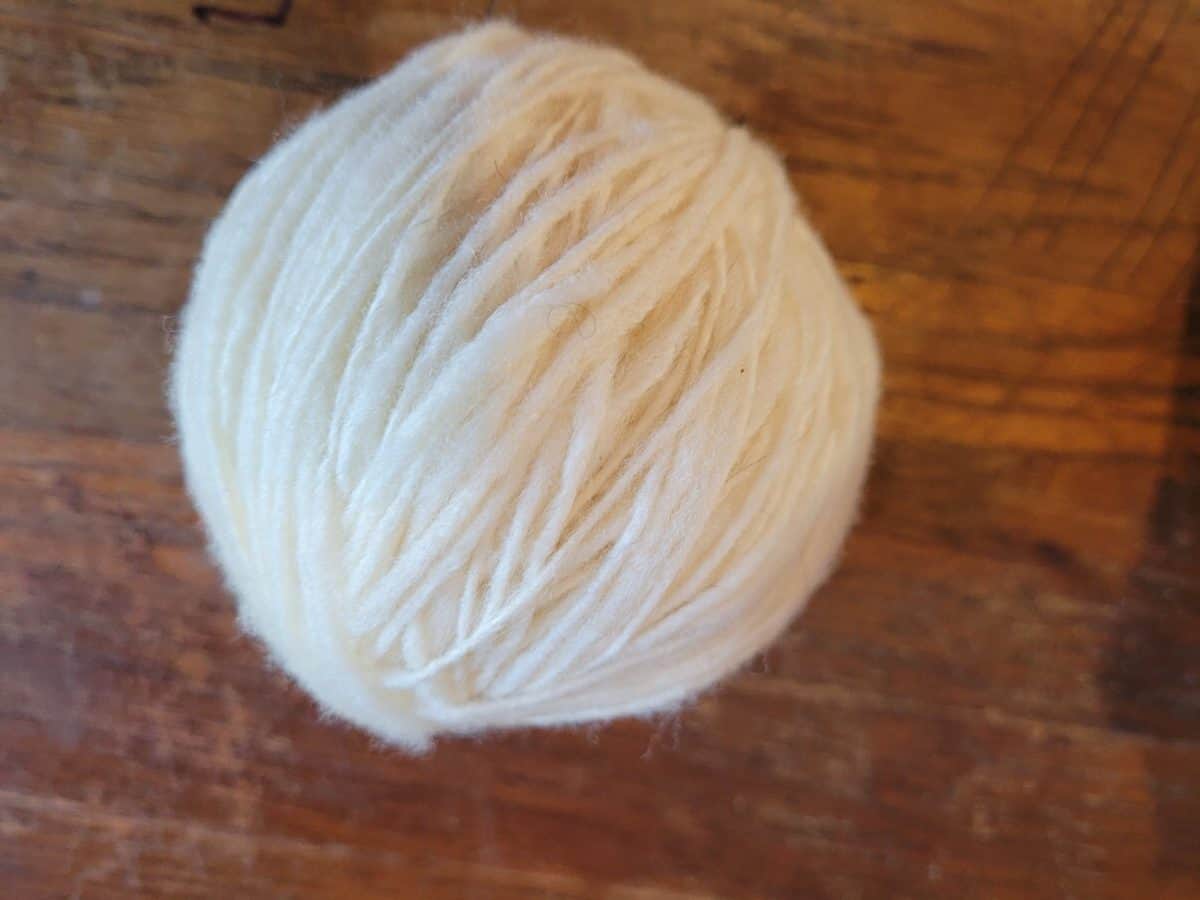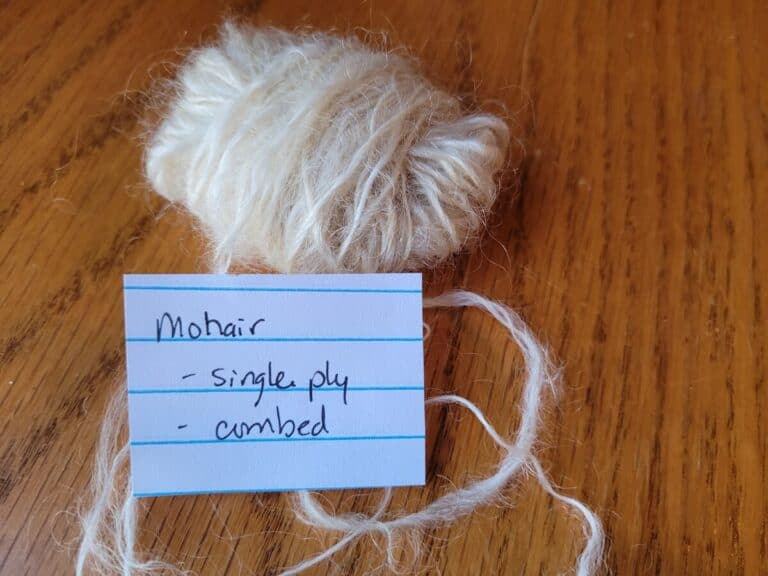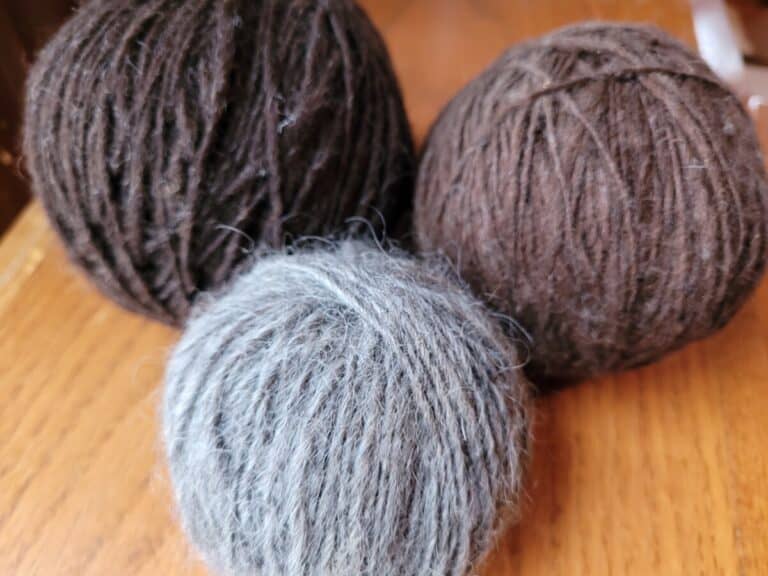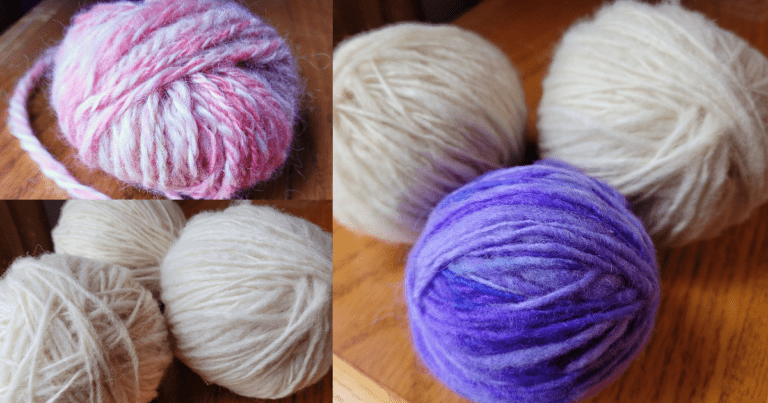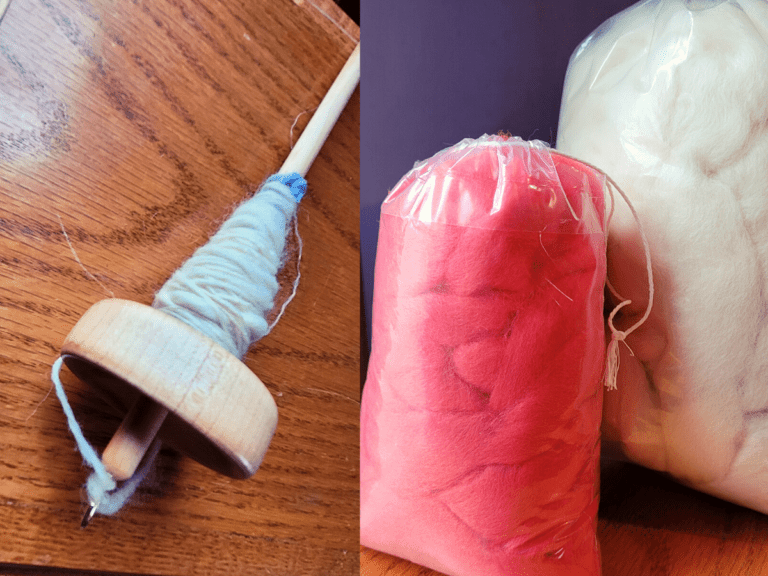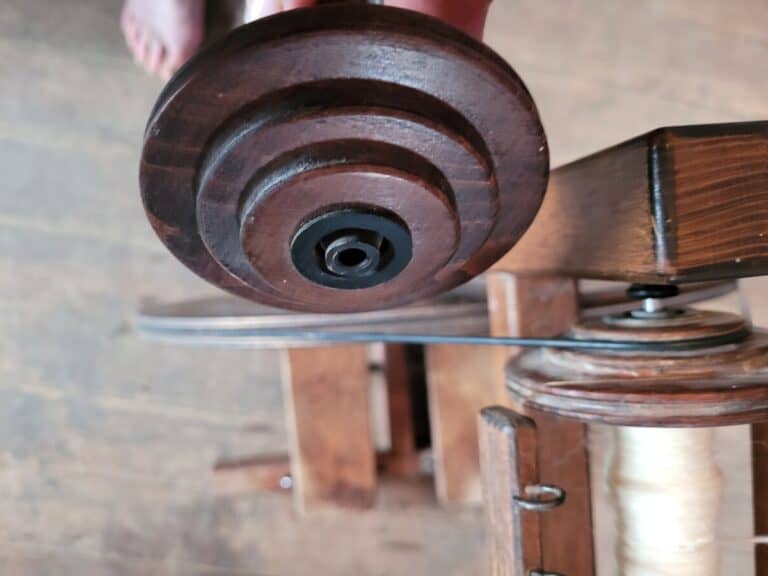Is Spinning Your Own Yarn Worth It?
There are a ton of handspinners out there who love to handcraft custom yarn and, of course, there are also scads of folks who love to work with yarn and will happily buy it from someone else.
Should you buy it or spin it? Is spinning your own yarn worth it for you?
Spinning your own yarn is worth your time and money if you learn to spin, instead of buy, specialty yarns. If you like to work with the commonly available mill spun wool yarn, spinning your own yarn will save some money, but not as much.
The “worth it” question seems to come down to two things, are you talking money or are you talking satisfaction and enjoyment? We’ll go over both!
Raw Wool vs Washed Wool goes over the pros and cons of working with each and gives suggestions on how to tell if a fleece is a good candidate for spinning in the grease (raw).
Looking for a spinning community to learn and grow together? Check out Woolmaven Handspinning, it’s a spinning course and community designed for beginners. Consider joining us, we’d love to have you!
Spinning your own yarn can save you money
Let’s start with the easy part of the question, will spinning your yarn be worth it in terms of saving money?
Spinning your own art yarn saves $
Overall, spinning your own yarn saves you money if you are wanting to work with the more unusual yarns, for instance, a lock spun yarn or a really wild core spun.
You can probably make these for less than you would pay to purchase them from a specialty shop.
Why? Because you are paying for the specialty fibers and the specialty skills to make those wonderful yarns.
The actual costs here are very tough to figure up, since so often the art yarns are a combination of all kinds of fibers and some really cool techniques on the part of the wool crafter.
The best I can do is point you toward some handspun yarn shops on Etsy.
Here is the only somewhat clear example of making versus buying art yarn that I found in a quick search: a coiled art yarn made of merino, which is 2.85 ounces for $27.98.
You could make something similar to this with the 8.8 ounces of multicolored merino top for $27.99 (listed below) while only using $9.08 of wool.
This means you are paying $18.90 for someone else to do the spinning for you to make this yarn.
Is is worth it for you to pay someone else $18.90 for this yarn? That’s the real question here and only you can decide if it’s worth it or not.
6 Hard To Spin Wools gives you a list of a few breed specific wools that need to be a bit later on your list if you are new to handspinning!
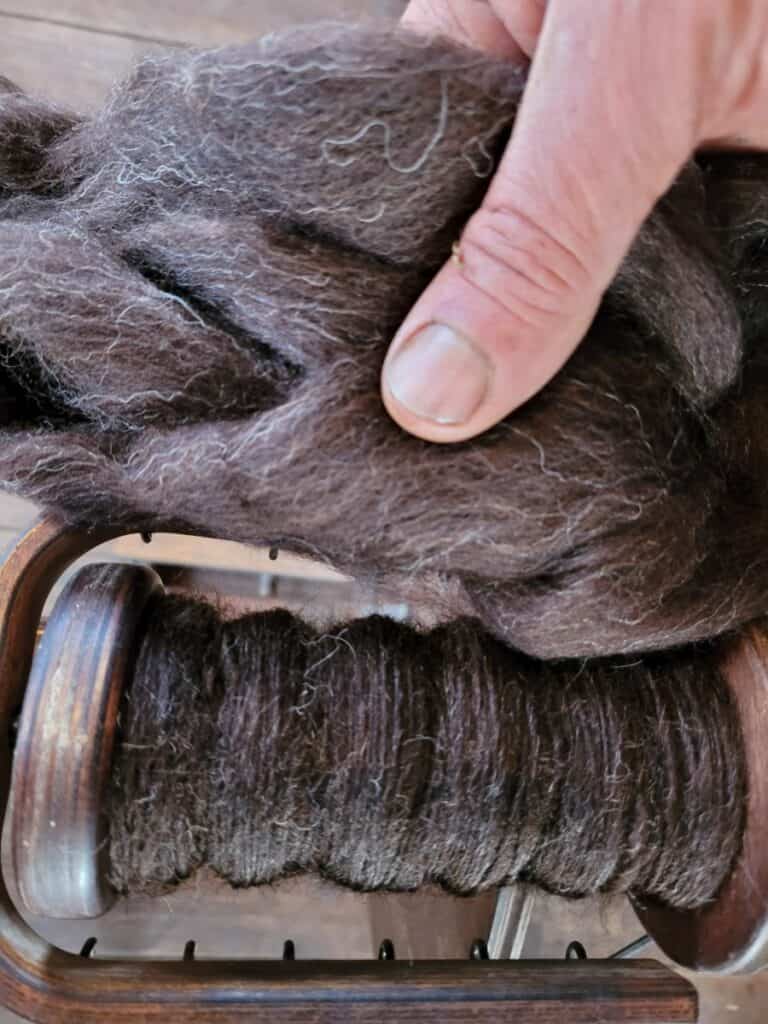
Spinning your own plain wool yarn
However, if you are wanting to use a fairly normal generic wool yarn and have your focus on your knitting for example, rather than the yarn, you need to focus on what your time is worth to you.
Of course, wool costs will depend upon what you use as your fiber source, both which shop you buy from as well as which fiber or fibers you buy!
Here are some examples of wool yarns available to buy and the cost making them yourself compared to buying the yarn mill spun for you.
I am getting prices from The Woolery, in March 2022. If you decide to shop at a different supplier, feel free to compare your own prices there.
Example 1:
Cestari Mt. Vernon Fine Merino 100% wool yarn is a two ply worsted weight yarn that is $17.99 and 3.5 ounces (100 grams). This yarn is $5.14 per ounce.
Fine merino that you would spin will cost you $17.99 for 8.8 ounces (250 grams).
This would be $2.04 per ounce for the wool to make a yarn comparable to the purchased Cestari yarn.
For this yarn, you are basically paying yourself or the yarn company $3.10 per ounce to spin your yarn.
Since this is a two ply worsted weight yarn, you can easily make this yarn yourself with a bit of practice.
Example 2:
If you want dyed wool to spin, it would cost you $27.99 for a multicolored merino top that is 250 grams (8.8 ounces), which is $3.18 per ounce of wool.
For this yarn, you would be paying yourself or the yarn company $1.96 to spin the yarn.
You do save money spinning your own yarn, less so if you are spinning a very normal yarn or one that is dyed, but still it is less out of pocket costs to spin your own yarn rather than buying yarn.
This post contains affiliate links, which means I receive commissions if you choose to purchase through links I provide (at no extra cost to you).
Cost of wheel
You’ll need to buy a wheel and that will cost you anywhere from around $500-900+.
Great wheels to start with are the Ashford Kiwi 3 or the Ashford Traditional. For more on beginner wheels, read my article 5 Easy To Use Beginner Friendly Spinning Wheels.
This one time purchase will last you for years, but you do have to cough up all the cash, upfront.
Of course, you can use a spindle, but I’m figuring you are using a wheel since you are most likely looking to make a more substantial amount of yarn.
Cost of the fiber
The other component to spinning your own yarn, of course, is the fiber. You can get 8 ounces for around $20 at The Woolery.
Price varies with the fiber, but $20 is a good price to start with.
Looking for a great resource on which fiber to pick and how best to use it? Consider getting The Fleece And Fiber Sourcebook, filled with wonderful pictures and details on just about any wool you can find.
Fiber is a reoccurring cost
Fiber is a reoccurring cost for every handspinner.
Popular examples of fiber are super fine Merino, which is 19 microns, so next to skin soft, or Polwarth, which is not quite as fine as Merino, but wonderful to work with. It’s one of my favorites!
The good news is that the cost per skein is easy to figure out, since you will have little to no fiber waste when you use professionally milled fibers.
This means that if you make a 2 ounce skein, you will have used right at 2 ounces of fiber. This makes your math easy, take the cost of your fiber per ounce and multiply by the weight of the finished skein.
The average cost of fiber that I have worked out tends to be in the $5 range per 2 ounce skein.
This is easy math, so if your fiber costs are significantly different use your costs, not the average!
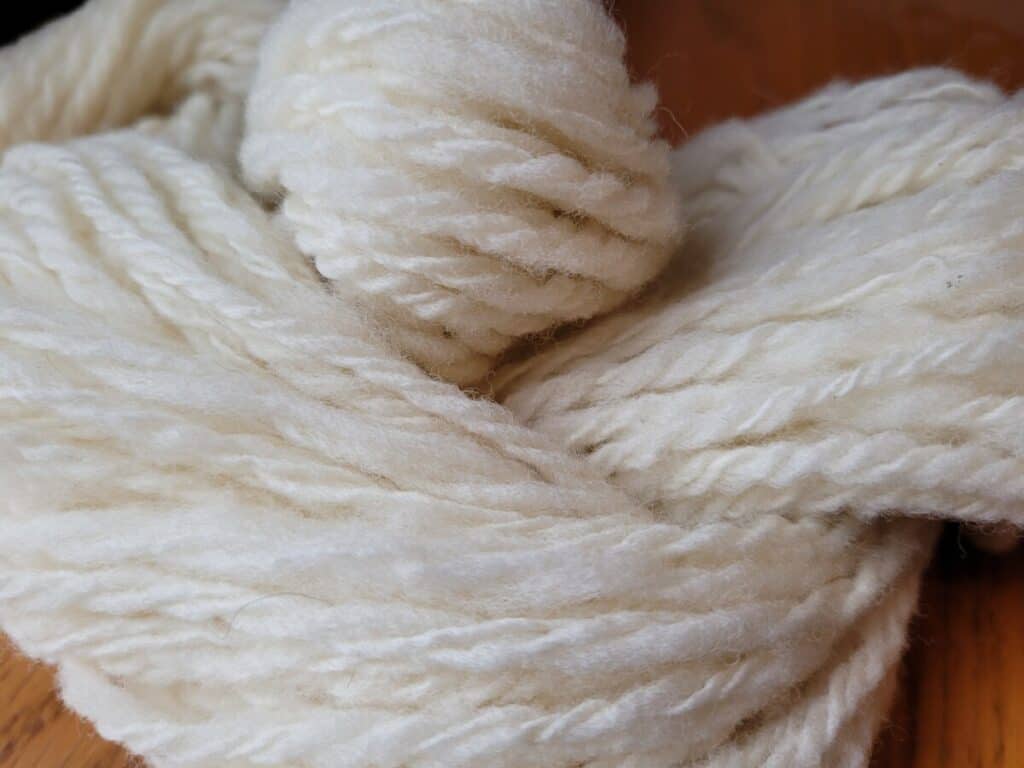
How To Get Wool Ready To Spin In The Grease will go over the steps you need to take to get your fleece ready to spin without washing!
Plain wool yarn is reasonably priced
The place where you are not going to be able to do much with the cost of your yarn is if you are buying a very normal, everyday wool yarn.
For instance a 100% wool worsted weight yarn and you are not concerned about the specific breed of wool used, you can get this yarn for a pretty reasonable price.
To be perfectly honest with you, you will be just fine with purchasing yarn, if you value your time at even $10 per hour (of course, your time is worth much more than that!).
Here’s the math I’m looking at: if you take 2 hours to make the yarn, this includes spinning, setting, skeining, whatever you need to do to make that roving into yarn, you’ll have $20 of labor in it.
Add to that $20 the cost of the roving, itself, which can be anywhere from $2-5+, you end up with $22-25+ per skein of ready to spin yarn.
Now, remember, you could also add in other cool stuff like dyes, which would add to the cost and time involved as well as more interesting fibers that would also add to the total fiber costs.
For now, we’re keeping it simple and making or buy just a pretty normal yarn, so we’ll stick with the $22-25 range.
Can you get the yarn you want for $22? From what I have seen, yes, you can.
Most of the 100% wool yarns I have seen are in the $12-14 range (plus shipping), which is under what you have in your yarn, once again, assuming you are okay with generic wool yarn.
Want to learn to spin? Woolmaven Handspinning is a beginner specific course with step by step lessons that will get you spinning on that wheel!
Spinning yarn gives you tons of options
Where spinning your own yarn really shines is when you want to have a very specific yarn or an unusual yarn for your project and you don’t see what you want for sale from anyone else.
Spinning your own yarn gives you nearly unlimited options.
This is the part that’s hard to put a price on, since the cost to make the yarn depends upon what you are putting into it.
For instance, if you see a great merino and silk blend top that you would spin, as is, then the fiber cost of the yarn is the cost of the combed top. That’s a simple one but a place to start.
Putting a price on options gets more complicated when you put in a little of this and a little of that into your carder then make a one of a kind batt.
Do you charge yourself for those extra bits, or were they leftovers from a previous project?
Or you do see the yarn for sale in the colors, weight and fiber you like, but look at the finished skein and the corresponding price and think “I could make that!”
Maybe that skein is lovely, but you would rather have a bit more blue, mohair, sparkle, etc. This is your chance to make exactly what you want and have the satisfaction of knowing you spun the yarn!
Change techniques=change results
There is also the spinning technique side of things, by which I mean that you can take the same fiber and get all manner of different yarns from it depending upon how you spin it!
You could take one bag of roving and turn it into singles, plyed yarns, core spun, woolen or worsted, not to mention all of your options once you get into color or dyes.
If you decide to really up your game, you can get into blending fibers, so you would make your own batts of what ever fibers you wanted and spin from that, the options are truly endless!
Handspinng for enjoyment
Now, we move onto the real core of the question “is spinning your own yarn worth it”: the love of handspinning itself.
I find spinning yarn to be a wonderful way to relax and clear my mind, like taking my dogs out for a walk. It just feels good!
I can even say that when I am working with a new to me fiber and I’m still fiddling around to figure out how to get the results I want, I enjoy the challenge.
Sure, while I was trying to figure it out and messing up I was frustrated, but when I finally do figure it out (and you will if you stick with it) I’m glad that kept going and have, once again, grown my skills.
Why Did You Learn To Spin Yarn? is an article in Spin Off listing out a variety of reasons for spinning, from custom weaving or knitting yarns to historical inspiration.
Amazing amount of wools to use
Right now, I am exploring some rovings that I have never worked with before, but seem neat or interesting to me.
I have found some wools that I was super excited about, but do not want to use for anything else just now and I have found some hidden gems that I am definitely getting more of! You never know!
This is just one aspect of handspinning that is so interesting!
For example:
- Have you tried Zwartbles? It’s a black wool that is easy to spin, I enjoy using it.
- What about using some Cheviot? Cheviot is a springy white wool that’s beginner friendly.
- Get some more natural color choices with Shetland. Shetland is a wonderful fiber that is getting more popular, especially for folks wanting to do more with naturally colored wools.
You can explore different wools or blends, start working with plant or synthetic fibers, do cool spinning techniques or get into colorwork!
To me, this is the real enjoyment to be found in handspinning my own yarn.
To tell you the truth, I am not such a great knitter (and even less great at crochet!), but I love to mess around making yarn!
I learned to knit so that I could use the yarn I was making, not so I could feed my knitting or crochet habit, I have a spinning habit!
If your first love is knitting, maybe you should buy yarn
If you are much more into knitting or crochet than spinning, it could easily be that spinning your own yarn will not be worth it to you and I can understand that! You only have so much focus!
Some folks love to control the process, from sheep to shawl, as the saying goes, but other folks really enjoy specific parts of wool work and would prefer to focus all their time on one aspect.
You have to know you and do the things that work best for you. If the idea of learning to spin your own wool sounds intriguing to you, give it a shot.
In my opinion, if you are just looking into learning to spin yarn to save money on your yarn based projects, you are probably not going to find handspinning to be worth it to you.
Decided to give spinning a try? Check out Woolmaven Handspinning and spin the yarns you’ve been craving!

